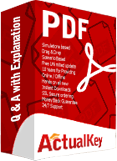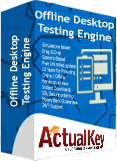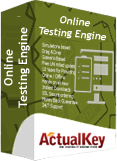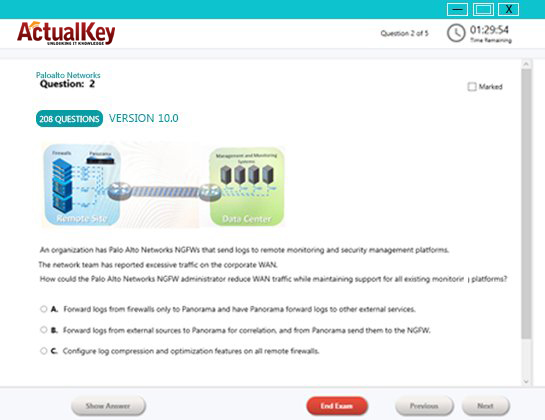Limited Time 30% Discount Offer Use Code - off30
Actualkey Prepration Latest MS-900 : Microsoft 365 Fundamentals Exam Questions and Answers PDF's, Verified Answers via Experts - Pass Your Exam For Sure and instant Downloads - "Money Back Guarantee".
| Vendor | Microsoft |
| Certification | Microsoft 365 |
| Exam Code | MS-900 |
| Title | Microsoft 365 Fundamentals Exam |
| No Of Questions | 391 |
| Last Updated | March 1,2025 |
| Product Type | Q & A with Explanation |
| Bundel Pack Included | PDF + Offline / Andriod Testing Engine and Simulator |
Updates to the exam
Our exams are updated periodically to reflect skills that are required to perform a role. We have included two versions of the Skills Measured objectives depending on when you are taking the exam.
We always update the English language version of the exam first. Some exams are localized into other languages, and those are updated approximately eight weeks after the English version is updated. While Microsoft makes every effort to update localized versions as noted, there may be times when localized versions of an exam are not updated on this schedule. Other available languages are listed in the Schedule Exam section of the Exam Details webpage. If the exam isn't available in your preferred language, you can request an additional 30 minutes to complete the exam.
Note
The bullets that follow each of the skills measured are intended to illustrate how we are assessing that skill. Related topics may be covered in the exam.
Note
Most questions cover features that are general availability (GA). The exam may contain questions on Preview features if those features are commonly used.
Skills measured as of January 22, 2024
Audience profile
This exam is designed for you, if you’re looking to demonstrate foundational-level knowledge of cloud-based solutions to facilitate productivity and collaboration among on-site, remote, and hybrid workers. As a candidate, you may:
Have knowledge of cloud-based solutions.
Be new to Microsoft 365.
You can use this exam to prepare for other Microsoft certifications, but it’s not a prerequisite for the related ones.
As a candidate, you should be able to recommend Microsoft 365 solutions that address common organizational IT challenges. You should understand how Microsoft 365 solutions:
Improve productivity
Facilitate collaboration
Optimize communications
Help secure data
Identity and facilitate compliance
You should be able to recommend solutions for:
Endpoint and application management
Desktop virtualization
Automated operating system deployment
Reporting and analytics
You should be familiar with Microsoft 365 licensing, deployment and migration assistance, and support options for organizations looking to maximize their investment in the cloud.
Skills at a glance
Describe cloud concepts (5–10%)
Describe Microsoft 365 apps and services (45–50%)
Describe security, compliance, privacy, and trust in Microsoft 365 (25–30%)
Describe Microsoft 365 pricing, licensing, and support (10–15%)
Describe cloud concepts (5–10%)
Describe the different types of cloud services available
Describe Microsoft software as a service (SaaS), infrastructure as a service (IaaS), and platform as a service (PaaS) concepts and use cases
Describe differences between Office 365 and Microsoft 365
Describe the benefits of and considerations for using cloud, hybrid, or on-premises services
Describe public, private, and hybrid cloud models
Compare costs and advantages of cloud, hybrid, and on-premises services
Describe the concept of hybrid work and flexible work
Describe Microsoft 365 apps and services (45–50%)
Describe productivity solutions of Microsoft 365
Describe the core productivity capabilities and benefits of Microsoft 365 including Microsoft Outlook and Microsoft Exchange, Microsoft 365 apps, and OneDrive
Describe core Microsoft 365 Apps including Microsoft Word, Excel, PowerPoint, Outlook, and OneNote
Describe work management capabilities of Microsoft 365 including Microsoft Project, Planner, Bookings, Forms, Lists, and To Do
Describe collaboration solutions of Microsoft 365
Describe the collaboration benefits and capabilities of Microsoft 365 including Microsoft Exchange, Outlook, SharePoint, OneDrive, and Stream
Describe the collaboration benefits and capabilities of Microsoft Teams and Teams Phone
Describe the Microsoft Viva apps
Describe the ways that you can extend Microsoft Teams by using collaborative apps
Describe endpoint modernization, management concepts, and deployment options in Microsoft 365
Describe the endpoint management capabilities of Microsoft 365 including Microsoft Endpoint Manager (MEM), Intune, AutoPilot, and Configuration Manager with cloud attach
Compare the differences between Windows 365 and Azure Virtual Desktop
Describe the deployment and release models for Windows-as-a-Service (WaaS) including deployment rings
Identify deployment and update channels for Microsoft 365 Apps
Describe analytics capabilities of Microsoft 365
Describe the capabilities of Viva Insights
Describe the capabilities of the Microsoft 365 Admin center and Microsoft 365 user portal
Describe the reports available in the Microsoft 365 Admin center and other admin centers
Describe security, compliance, privacy, and trust in Microsoft 365 (25–30%)
Describe identity and access management solutions of Microsoft 365
Describe the identity and access management capabilities of Microsoft Entra ID
Describe cloud identity, on-premises identity, and hybrid identity concepts
Describe how Microsoft uses methods such as multi-factor authentication (MFA), self-service password reset (SSPR), and conditional access, to keep identities, access, and data secure
Describe threat protection solutions of Microsoft 365
Describe Microsoft 365 Defender, Defender for Endpoint, Defender for Office 365, Defender for Identity, Defender for Cloud Apps, and the Microsoft 365 Defender Portal
Describe Microsoft Secure Score benefits and capabilities
Describe how Microsoft 365 addresses the most common types of threats against endpoints, applications, and identities
Describe trust, privacy, risk, and compliance solutions of Microsoft 365
Describe the Zero Trust Model
Describe Microsoft Purview compliance solutions such as insider risk, auditing, and eDiscovery
Describe Microsoft Purview Information Protection features such as sensitivity labels and data loss prevention
Describe how Microsoft supports data residency to ensure regulatory compliance
Describe the capabilities and benefits of Microsoft Priva
Describe Microsoft 365 pricing, licensing, and support (10–15%)
Identify Microsoft 365 pricing and billing management options
Describe the pricing model for Microsoft cloud services including enterprise agreements, cloud solution providers, and direct billing
Describe available billing and bill management options including billing frequency and methods of payment
Identify licensing options available in Microsoft 365
Describe license management
Describe the differences between base licensing and add-on licensing
Identify support options for Microsoft 365 services
Describe how to create a support request for Microsoft 365 services
Describe support options for Microsoft 365 services
Describe service-level agreements (SLAs) including service credits
Determine service health status by using the Microsoft 365 admin center or the Microsoft Entra admin center
QUESTION 2
You need to consider the underlined segment to establish whether it is accurate.
All applications will remain in a hybrid environment after migrating to Microsoft Azure.
Select '''?No adjustment required'''? if the underlined segment is accurate. If the underlined segment is inaccurate,
select the accurate option.
A. No adjustment required.
B. Applications that manage sensitive information
C. Applications where access requires a USB-token device
D. All legacy applications
Answer: B
QUESTION 3
Note: The question is included in a number of questions that depicts the identical set-up. However,
every question has a distinctive result. Establish if the solution satisfies the requirements.
Your company plans to move their Server environment to the cloud.
You have been tasked with identifying a cloud model that allows for the current email environment to be
upgraded, while also reducing server and application maintenance.
You need to make sure that the requirements are met.
Solution: You recommend the Platform as a service (PaaS) model.
Does the solution meet the goal?
A. Yes
B. No
Answer: B
QUESTION 4
Note: The question is included in a number of questions that depicts the identical set-up. However,
every question has a distinctive result. Establish if the solution satisfies the requirements.
Your company plans to move their Server environment to the cloud.
You have been tasked with identifying a cloud model that allows for the current email environment to be
upgraded, while also reducing server and application maintenance.
You need to make sure that the requirements are met.
Solution: You recommend the Infrastructure as a service (IaaS) model.
Does the solution meet the goal?
A. Yes
B. No
Answer: B
QUESTION 5
Note: The question is included in a number of questions that depicts the identical set-up. However,
every question has a distinctive result. Establish if the solution satisfies the requirements.
Your company plans to move their Server environment to the cloud.
You have been tasked with identifying a cloud model that allows for the current email environment to be
upgraded, while also reducing server and application maintenance.
You need to make sure that the requirements are met.
Solution: You recommend the Software as a service (SaaS) model.
Does the solution meet the goal?
A. Yes
B. No
Answer: A
QUESTION 6
Your company makes use of Platform as a Service (PaaS) for their Azure solution.
Which of the following options are components that your IT employees are responsible for?
A. Networks.
B. Databases.
C. Applications.
D. Servers.
Answer: C
QUESTION 7
Your company makes use of Platform as a Service (PaaS) for their Azure solution.
Which of the following options are components that Microsoft are responsible for? (Choose all that apply).
A. Storage.
B. Databases.
C. Applications.
D. Operating system.
Answer: A,B,D
QUESTION 8
Your company is planning to migrate to Microsoft Azure and Microsoft 365.
You are required to identify a cloud service that allows for website hosting.
Which of the following is the model you should choose?
A. Software as a Service (SaaS)
B. Platform as a Service (PaaS)
C. Infrastructure as a Service (IaaS)
D. Container as a Service (CaaS)
Answer: B
QUESTION 9
Your company is planning to migrate to Microsoft Azure and Microsoft 365.
You are required to identify a cloud service that allows for the deployment of a Linux virtual machine.
Which of the following is the model you should choose?
A. Software as a Service (SaaS)
B. Platform as a Service (PaaS)
C. Infrastructure as a Service (IaaS)
D. Container as a Service (CaaS)
Answer: C
QUESTION 11
You need to consider the underlined segment to establish whether it is accurate.
To ensure that when a new Microsoft Word feature is available for worker to install as soon as it becomes
available, you should subscribe to the Targeted release channel.
Select '''?No adjustment required'''? if the underlined segment is accurate. If the underlined segment is inaccurate,
select the accurate option.
A. No adjustment required.
B. Standard release
C. Semi-annual
D. Annual
Answer: A
I Got My Success Due To Actualkey MS-900 Bundle Pack Actualkey experts I got passed in the MS-900 exam without any worries at all, these exam material products gave me the reason to relax.
Budi Saptarmat
Yahoo! Got Successfully Through The MS-900 Exam Passing Exam is not a easy thanks to Acutalkey.com for providing me actual MS-900 Microsoft 365 Fundamentals Exam training with there included the Offline and Android simulators helps me success
Melinda
MS-900 Exam Best Preparation I have been preparing for MS-900 Microsoft 365 Fundamentals Exam, I was not sure that I'll be able to pass because of the fact that I am not a good student however;Actualkey.com provided me best and simple exam training pdf's and I passed. I now recommend everyone
Antonio Moreno
Actualkey.com MS-900 Offline Simulator is Best My choice to select Actualkey.com and go for the preparation MS-900 Microsoft 365 Fundamentals Exam, because I got the short way with the easy way
Liliane Meichner
Actualkey.com MS-900 Exam PDF"s passed with in a week MS-900 exam pdf's that's amazing
James Wilson
Microsoft - RELATED EXAMS
Designing a Database Server Infrastructure by Using Microsoft SQL Server 2005
Questions: 92 Questions | September 16, 2024
Optimizing and Maintaining a Database Administration Solution by Using SQL Server 2005
Questions: 215 | September 16, 2024
UPGRADE: MCDBA Skills to MCITP Database Administrator by Using Microsoft SQL Server 2005
Questions: 186 Questions | September 16, 2024
Microsoft .NET Framework 2.0 - Windows-Based Client Development
Questions: 245 Questions | September 16, 2024
Microsoft .NET Framework 2.0 - Distributed Application Development
Questions: 144 | September 16, 2024
Microsoft .NET Framework 2.0-Application Development Foundation
Questions: 456 | September 16, 2024
Designing and Developing Web-Based Applications by Using the Microsoft .NET Framework
Questions: 74 | September 16, 2024
Designing and Developing Windows-Based Applications by Using the Microsoft .NET Framework
Questions: 72 Questions | September 16, 2024
Designing and Developing Enterprise Applications by Using the Microsoft .NET Framework
Questions: 86 | September 16, 2024
UPGRADE: MCAD Skills to MCPD Web Developer by Using the Microsoft .NET Framework
Questions: 584 | September 16, 2024
UPGRADE: MCAD Skills to MCPD Windows Developer by Using the Microsoft .NET Framework
Questions: 559 | September 16, 2024
UPGRADE: MCSD Microsoft .NET Skills to MCPD Enterprise Application Developer: Part 1
Questions: 609 | September 16, 2024
UPGRADE: MCSD Microsoft .NET Skills to MCPD Enterprise Application Developer: Part 2
Questions: 168 | September 16, 2024
TS: Deploying and Maintaining Windows Vista Client and 2007 Microsoft Office System Desktops
Questions: 92 | September 16, 2024
Windows Server 2008 Applications Infrastructure, Configuring
Questions: 494 | September 16, 2024
TS: Upgrading from Windows Server 2003 MCSA to, Windows Server 2008, Technology Specializations
Questions: 576 | September 16, 2024
Designing a Microsoft Office Enterprise Project Management (EPM) Solution
Questions: 50 Questions | September 16, 2024
Customizing Portal Solutions with Microsoft SharePoint Products and Technologies
Questions: 75 | September 16, 2024
Deploying Business Desktops with Microsoft Windows Server 2003 and Microsoft Office 2003
Questions: 53 | September 16, 2024
Implementing and Administering Security in a Microsoft Windows Server 2003 Network
Questions: 288 | September 16, 2024
Designing, Deploying, and Managing a Network Solution for a Small- and Medium-Sized Business
Questions: 204 | September 16, 2024
Supporting Users and Troubleshooting a Microsoft Windows XP Operating System
Questions: 114 | September 16, 2024
TS: Microsoft SQL Server 2008, Business Intelligence Development and Maintenance
Questions: 399 | September 16, 2024
PRO: Designing, Optimizing and Maintaining a Database Administrative Solution Using Microsoft SQL Server 2008
Questions: 189 | September 16, 2024
Developing E-Business Solutions Using Microsoft BizTalk Server 2004
Questions: 40 | September 16, 2024
Developing Microsoft Office Solutions Using XML with Office Professional Edition 2003
Questions: 50 | September 16, 2024
Planning and Building a Messaging and Collaboration Environment Using Microsoft Office System and Microsoft Windows Server 2003
Questions: 61 | September 16, 2024
TS: Microsoft .NET Framework 3.5, ADO.NET Application Development
Questions: 287 | September 16, 2024
TS: Microsoft .NET Framework 3.5, ASP.NET Application Development
Questions: 364 | September 16, 2024
TS: Microsoft Office Project Server 2007, Managing Projects
Questions: 145 | September 16, 2024
TS: Microsoft .NET Framework 3.5, Windows Forms Application Development
Questions: 48 | September 16, 2024
Upgrade: Transition Your MCITP SQL Server 2005 DBA to MCITP SQL Server 2008
Questions: 98 | September 16, 2024
Pro: Designing and Deploying Messaging Solutions with Microsoft Exchange Server 2010
Questions: 379 | July 1, 2024
Pro: Designing and Developing ASP.NET Applications Using the Microsoft .NET Framework 3.5
Questions: 281 | September 16, 2024
TS: Microsoft SQL Server 2008, Implementation and Maintenance
Questions: 328 | September 16, 2024
Microsoft System Center Configuration Manager 2007,Configuring
Questions: 184 | September 16, 2024
PRO: Designing and Developing Microsoft SharePoint 2010 Applications
Questions: 200 | September 16, 2024
Upgrading to Windows 7 MCITP Enterprise Desktop Support Technician
Questions: 50 | September 16, 2024
TS: Windows Applications Development with Microsoft .NET Framework 4
Questions: 278 | September 16, 2024
TS: Windows Communication Foundation Development with Microsoft .NET Framework 4
Questions: 473 | September 16, 2024
TS: Web Applications Development with Microsoft .NET Framework 4
Questions: 405 | September 16, 2024
Pro: Designing and Developing Web Applications Using Microsoft .NET Framework 4
Questions: 288 | September 16, 2024
TS: Developing Business Process and Integration Solutions by Using Microsoft BizTalk Server 2010
Questions: 100 | September 16, 2024
Designing and Providing Microsoft Volume Licensing Solutions to Small and Medium Organizations
Questions: 232 | September 16, 2024
TS: Forefront Protection for Endpoints and Applications, Configuring
Questions: 105 | September 16, 2024
Upgrade: Transition Your MCITP SQL Server 2005 DBD to MCITP SQL Server 2008 DBD
Questions: 154 | July 1, 2024
Pro: Windows Server 2008 R2, Virtualization Administrator
Questions: 176 | September 16, 2024
PRO: Designing Database Solutions and Data Access Using Microsoft SQL Server 2008
Questions: 183 | July 1, 2024
Managing and Maintaining a Microsoft Windows Server 2003 Environment
Questions: 450 | July 1, 2024
Implementing Data Models and Reports with Microsoft SQL Server 2012
Questions: 330 | July 1, 2024
Implementing a Data Warehouse with Microsoft SQL Server 2012
Questions: 322 | September 16, 2024
Transition Your MCTS on SQL Server 2008 to MCSA: SQL Server 2012, Part 2
Questions: 300 | September 16, 2024
Configuring and Deploying a Private Cloud with System Center 2012
Questions: 462 | September 16, 2024
Monitoring and Operating a Private Cloud with System Center 2012
Questions: 457 | September 16, 2024
Administering and Deploying System Center 2012 Configuration Manager
Questions: 208 | September 16, 2024
Microsoft Dynamics AX 2012 Process Manufacturing Production and Logistics
Questions: 149 | July 1, 2024
Advanced Metro style App Development using HTML5 and JavaScript
Questions: 225 | September 16, 2024
Transition Your MCTS on SQL Server 2008 to MCSA: SQL Server 2012, Part 1
Questions: 230 | September 16, 2024
Transition Your MCITP: Database Administrator 2008 or MCITP: Database Developer 2008 to MCSE: Data Platform
Questions: 261 | September 16, 2024
Transition Your MCITP: Business Intelligence Developer 2008 to MCSE: Business Intelligence
Questions: 132 | September 16, 2024
Designing Database Solutions for Microsoft SQL Server 2012
Questions: 231 | September 16, 2024
Designing Business Intelligence Solutions with Microsoft SQL Server 2012 Exam
Questions: 314 | September 16, 2024
Microsoft Programming in HTML5 with JavaScript and CSS3 Exam
Questions: 342 | September 16, 2024
Delivering Continuous Value with Visual Studio 2012 Application Lifecycle Management
Questions: 219 | July 1, 2024
Enterprise Voice & Online Services with Microsoft Lync Server 2013
Questions: 158 | September 16, 2024
Developing Microsoft SharePoint Server 2013 Core Solutions
Questions: 181 | September 16, 2024
Upgrade your MCPD: Web Developer 4 to MCSD: Web Applications
Questions: 229 | September 16, 2024
Essentials of Developing Windows Metro style Apps using C#
Questions: 168 | September 16, 2024
Server Virtualization with Windows Server Hyper-V and System Center
Questions: 149 | September 16, 2024
Essentials of Developing Windows Metro style Apps using HTML5 and JavaScript
Questions: 166 | September 16, 2024
TS: Windows Small Business Server 2011 Standard, Configuring
Questions: 55 | September 16, 2024
TS: MS Internet Security & Acceleration Server 2006, Configuring
Questions: 80 | September 16, 2024
TS: Microsoft System Center Operations Manager 2007, Configuring
Questions: 94 | September 16, 2024
TS: System Center Virtual Machine Manager 2008, Configuring
Questions: 45 | September 16, 2024
PRO: Designing a Business Intelligence Infrastructure Using Microsoft SQL Server 2008
Questions: 115 | September 16, 2024
Upgrade: Transition Your MCITP SQL Server 2005 BI Developer to MCITP SQL Server 2008 BI Developer
Questions: 203 | September 16, 2024
Recertification for MCSD: Application Lifecycle Management
Questions: 292 | September 16, 2024
TS: Microsoft .NET Framework 3.5 Windows Presentation Foundation Application Development
Questions: 101 | September 16, 2024
TS: Microsoft .NET Framework 3.5 - Windows Communication Foundation
Questions: 270 | September 16, 2024
TS: Visual Studio Team Foundation Server 2010, Administration
Questions: 72 | September 16, 2024
Pro: Designing and Developing Windows Applications Using Microsoft .NET Framework 4
Questions: 239 | September 16, 2024
TS: Microsoft Windows SharePoint Services 3.0 Application Development
Questions: 109 | September 16, 2024
Upgrade: Transition your MCPD Enterprise Application Developer Skills to MCPD Enterprise Application Developer 3.5, Part 1
Questions: 153 | September 16, 2024
UPGRADE: Transition your MCPD Enterprise Application Developer Skills to MCPD Enterprise Application Developer 3.5, Part 2
Questions: 123 | September 16, 2024
TS: System Center Data Protection Manager 2007, Configuring
Questions: 74 | September 16, 2024
Designing and Providing Microsoft Volume Licensing Solutions to Large Organizations
Questions: 126 | September 16, 2024
TS: Designing, Assessing, and Optimizing Software Asset Management (SAM)
Questions: 85 | September 16, 2024
MS Office Communication Server 2007-U.C Voice Specialization
Questions: 174 | September 16, 2024
Microsoft Office Communications Server 2007 R2 U.C. Voice Specialization
Questions: 101 | September 16, 2024
Windows Server 2008 Hosted Environments, Configuring and Managing
Questions: 75 | September 16, 2024
Designing and Providing Microsoft Volume Licensing Solutions to Large Organisations
Questions: 104 | September 16, 2024
Pro: Designing and Developing Windows Applications Using the Microsoft .NET Framework 3.5
Questions: 105 | July 1, 2024
Pro: Designing and Developing Enterprise Applications Using the Microsoft .NET Framework 3.5
Questions: 152 | September 16, 2024
Universal Windows Platform – App Data, Services, and Coding Patterns (beta)
Questions: 47 | September 16, 2024
Universal Windows Platform – App Architecture and UX/UI (beta)
Questions: 76 | September 16, 2024
Microsoft Dynamics AX 2012 R3 CU8 Installation and Configuration
Questions: 48 | July 1, 2024
Designing and Deploying Microsoft Exchange Server 2016 Exam
Questions: 166 | September 16, 2024
Introduction to Programming Using Block-Based Languages (Touch Develop)
Questions: 72 | July 1, 2024
Development, Extensions and Deployment for Microsoft Dynamics 365 for Finance and Operations
Questions: 90 | July 1, 2024
Financial Management in Microsoft Dynamics 365 for Finance and Operations
Questions: 73 | July 1, 2024
Designing and Providing Microsoft Licensing Solutions to Large Organizations
Questions: 195 | July 1, 2024
Distribution and Trade in Microsoft Dynamics 365 for Finance and Operations
Questions: 93 | July 1, 2024
Administering Microsoft System Center Configuration Manager and Cloud Services Integration
Questions: 150 | July 1, 2024
Microsoft Configuring and Operating a Hybrid Cloud with Microsoft Azure Stack Exam
Questions: 99 | July 1, 2024
Microsoft Azure Solutions Architect Certification Transition Exam
Questions: 393 | July 1, 2024
Outlook 2016: Core Communication, Collaboration and Email Skills
Questions: 35 | July 1, 2024
Microsoft Developing Solutions for Microsoft Azure Exam
Questions: 170 / 6 Case Study | July 1, 2024
Designing and Implementing a Data Science Solution on Azure Exam
Questions: 442 | December 3, 2024
Microsoft 365 Teamwork Administrator Certification Transition Exam
Questions: 120 | July 1, 2024
Microsoft Messaging Administrator Certification Transition Exam
Questions: 155 | July 1, 2024
Microsoft Excel 2016: Core Data Analysis, Manipulation, and Presentation Exam
Questions: 35 | November 8, 2024
Microsoft Word 2016: Core Document Creation, Collaboration and Communication Exam
Questions: 35 | November 8, 2024
Microsoft Dynamics 365 for Finance and Operations, Supply Chain Management Exam
Questions: 394 | November 25, 2024
Microsoft Dynamics 365 for Finance and Operations, Manufacturing Exam
Questions: 207 | November 8, 2024
Building Applications and Solutions with Microsoft 365 Core Services Exam
Questions: 242 | July 1, 2024
Microsoft Dynamics 365: Finance and Operations Apps Solution Architect Exam
Questions: 295 | February 18, 2025
Planning and Administering Microsoft Azure for SAP Workloads Exam
Questions: 652 | July 1, 2024
Microsoft Dynamics 365: Finance and Operations Apps Developer Exam
Questions: 283 | February 21, 2025
Administering Relational Databases on Microsoft Azure (beta) Exam
Questions: 341 | December 13, 2024
Microsoft Dynamics 365 Business Central Functional Consultant (beta) Exam
Questions: 196 | March 8, 2025
Microsoft Power Platform Functional Consultant (beta) Exam
Questions: 289 | February 18, 2025
Configuring and Operating a Hybrid Cloud with Microsoft Azure Stack Hub Exam
Questions: 176 | July 1, 2024
Microsoft Dynamics 365 Fundamentals Customer Engagement Apps (CRM) (beta) Exam
Questions: 159 | October 12, 2024
Microsoft Dynamics 365 Fundamentals Finance and Operations Apps (ERP) Exam
Questions: 146 | February 14, 2025
Configuring and Operating Windows Virtual Desktop on Microsoft Azure Exam
Questions: 207 | February 20, 2025
Designing and Implementing a Microsoft Azure AI Solution (beta) Exam
Questions: 321 | December 2, 2024
Designing and Implementing Microsoft Azure Networking Solutions Exam
Questions: 294 | March 1, 2025
Designing Microsoft Azure Infrastructure Solutions (beta) Exam
Questions: 324 | January 16, 2025
Designing and Implementing Cloud-Native Applications Using Microsoft Azure Cosmos DB (beta) Exam
Questions: 140 | January 28, 2025
Configuring Windows Server Hybrid Advanced Services (beta) Exam
Questions: 157 | October 22, 2024
Administering Windows Server Hybrid Core Infrastructure (beta) Exam
Questions: 334 | September 2, 2024
Microsoft Designing and Implementing Enterprise-Scale Analytics Solutions Using Microsoft Azure and Microsoft Power BI Exam
Questions: 160 | July 1, 2024
Microsoft Dynamics 365 Supply Chain Management Functional Consultant Expert Exam
Questions: 152 | August 20, 2024
Implementing Analytics Solutions Using Microsoft Fabric Exam
Questions: 117 | February 21, 2025
Implementing Data Engineering Solutions Using Microsoft Fabric Exam
Questions: 67 | January 9, 2025
Exams code, certifications, vendor or keywords
![]()
Copyright © 2009 - 2025 Actualkey. All rights reserved.





